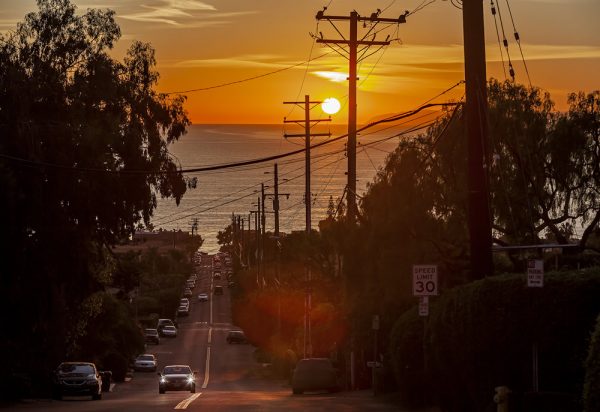
By Allison Jarrell, Special to the Independent
Laguna Beach voters are poised to decide the fate of the city’s push to underground its utilities during the election in November.
After hearing nearly two hours of community feedback, the City Council voted unanimously Tuesday, March 22, to draft ballot language seeking voter approval of a one-cent sales tax hike, dedicated to funding the burying of overhead utility poles and wires along Laguna Canyon Road and other evacuation routes.
The council also voted to create districts that would utilize financial credits from utilities and existing city revenue to underground utilities along Coast Highway between Agate Street and Upland Road, and along Monterey and Virginia Street between West Street and Fifth Avenue.
Staff will prepare and present the ballot language at the council’s June 26 meeting.
City officials said they’ve been working to address fire risk and evacuation issues since 2015, including more focused efforts over the last six months to find funding.
To learn the public’s views on funding the project, estimated to cost $115 million to $135 million, the city hired consultant FM3 Research to conduct two surveys of residents. City officials also recently held a public forum on the topic.
The results of the second survey, which polled 416 random residents, were presented Tuesday. It showed that about 76 percent of voters surveyed are at least somewhat supportive of undergrounding utilities, and 65 percent of those surveyed would support a one-cent sales tax, which requires a two-thirds vote to pass.
But the majority of residents surveyed—about 57 percent—opposed the addition of a $35 million general obligation bond measure, which would have cost homeowners about $11 per $100,000 of assessed property value annually. Thus, the property tax option was dropped from consideration.
Some residents questioned the survey, saying the questions were crafted with confusing, biased language. Resident Jennifer Sterling said the survey was continually “persuading people to say yes, even if they really kept saying no.”
Staff proposed a combination of two other funding sources to pay for the undergrounding of 12 key evacuation routes—the one-cent sales tax, which could potentially raise $5.5 million per year and support an $80 million bond, and $2.5 million of existing city revenue annually, which could support a $35 million bond. The city’s contribution would consist of $1 million from Measure LL, $800,000 from the city’s parking fund and $700,000 from the street lighting fund.
The combination of fund sources would ideally cover the $8 million per year in bond debt service required for the low estimate of the total project cost of $115 million.
Two community groups on both sides of the hot-button issue were invited to make 10-minute presentations prior to the rest of the public comments.
Resident Michael Morris spoke on behalf of S.T.O.P. (Stop Taxing Our Property), a group opposed to increasing taxes to fund the undergrounding.
Morris said the city’s claim that two-thirds of the increased sales tax will be paid for by tourists is unproven, and he worried that there is no sunset date mentioned for the tax.
If approved, the one-cent sales tax measure would increase Laguna’s sales tax by about 13 percent, to 8.75 percent from 7.75 percent, which is the highest rate in the county. Four other cities in the county share that rate—Fountain Valley, La Palma, Stanton and Westminster—and other than La Habra, which has an 8.25 percent sales tax, all other cities in the county exact a 7.75 percent sales tax.
Morris added that S.T.O.P believes the city is low-balling cost estimates and said it seems “imprudent” to spend so much money on two roads—Coast Highway and Laguna Canyon—that the city doesn’t control.
Morris suggested “an evidence-based, fiscally prudent approach to enhancing public safety in Laguna Beach,” including pursuing a pay-as-you-go model that utilizes existing city revenues first to tackle top-ranked priorities. “New taxes on residents should be the last resort,” Morris said.
Support for the measure came from Underground Laguna Now, whose backers argued that the public supports the effort for investing in public safety and improving aesthetics.
Resident Karen Klammer cited city data that at least six fires ignited locally due to power lines and utility equipment since 2008.
“One fallen pole could block hundreds of families from getting to safety or receiving essential help from first responders,” Klammer said.
Tom Gibbs said “sales tax funding makes sense,” adding that “those taxes are predominantly paid, unquestionably, by the 6.2 million visitors that come to our community.”
Just under 50 speakers addressed the council, both for and against the funding proposal, including several survivors of the 1993 fire that destroyed 440 homes in Laguna. Some brought up the potential for solar power as an alternative, while some on both sides agreed that a sunset date for the sales tax should be included in the measure.
The council took considerably less time to deliberate and voiced overall support for placing the sales tax measure on the ballot.
“We’ve tried to work with utilities, and the idea that Caltrans is going to come along and pay to do all of the undergrounding in the canyon, that’s a fallacy. It won’t happen,” Zur Schmiede said. “We’re going to have to bring some resources to the table.”
Zur Schmiede said undergrounding should still be pursued even as solar energy should be encouraged.
Council member Steve Dicterow voiced multiple concerns over the merits of the proposal. These included draining money from the parking and street lighting funds that could fund other projects, the effect of changing technology, the level of safety gained versus the project cost, fairness to residents who have already paid to underground utilities in their own neighborhood and avoiding advocacy.
“I feel that in the recent past we may have been crossing the line, and I want us to be very careful going forward,” he said.
“These are important issues, and they’re controversial,” Dicterow said. “That’s exactly when we should be going to a vote of the people in town.”





You may get the tourists and the last remaining locals who won’t go out of town and are willing to buy stuff at inflated prices to pay the sales tax, but that $135 million only pays for evacuation routes. There are still 4000 property owners whose meters are not Underground and the City’s own web site estimates it will cost $190 million to put them underground ($190M/4000=$47,500 per household). I don’t want to have my property taxes jacked up to pay that. And if given the choice would rather spend that money to convert to solar if forced. Did you know that to form an assessment district, 60% of you neighbors can force you into the district and based on weighted assessments 51% can force you to pay your assessed amount even if you didn’t vote for it? At least the with the sales tax you can leave town and avoid it.
[…] in the county. City officials intend to use the extra revenue to underwrite a safety measure, the burying of utility wires along Laguna Canyon Road and other key […]